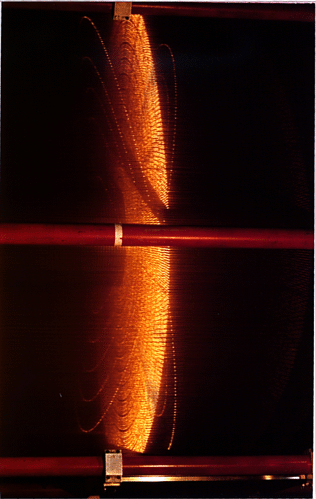Charged particle trajectories are measured with a set of three concentric, cylindrical wire drift chambers. Charged particles passing through the chambers ionize the gas in the chambers (DME or an argon/ethane mixture), and the resulting ionization is collected by wires maintained at high voltage relative to the surrounding "field" wires. The electrical signals from these wires are amplified, digitized, and fed into a computer which reconstructs the path of the original particle from the wire positions and signal delay times.
The outer drift chamber in the CLEO II detector has an inner radius of 17.5 centimeters and an outer radius of 95 centimeters. It is used primarily to measure charged particle momentum vectors at the vertex and particle identities. Momentum transverse to the beam axis is measure with 40 concentric rings of axial wires; logitudinal measurements are made with 11 concentric rings of wires where one end of the ring is twisted with respect to the other, creating a small "stereo" angle, and by two layers of segmented cathodes at the inner and outer diameters of the detector. The CLEO II outer drift chamber has a total of 12,240 high voltage wires and 36,240 field wires, arranged in 51 layers of cells, 3 layers of field wires per cell.
In this picture, the wires were illuminated with a narrow band of light. The points off to the side of the main band are the wires from the twisted "stereo" layers:

In the 1.5 Tesla field provided by the superconducting coil, a particle with a transverse momentum of 90 MeV/c only crosses 7 layers of the outer drift chamber. In order to better measure such low momentum particles, the CLEO II detector includes two smaller vertex chambers fitted inside the inner diameter of the outer drift chamber.